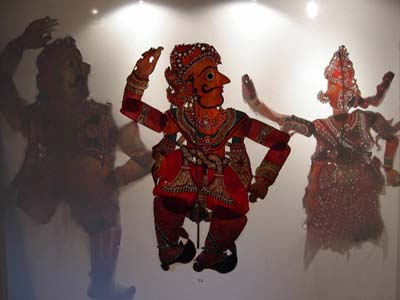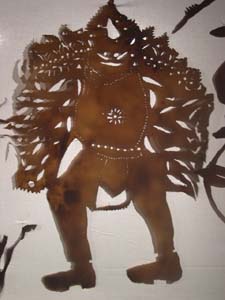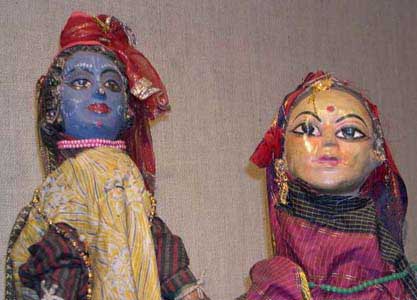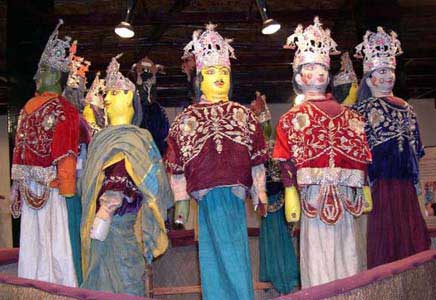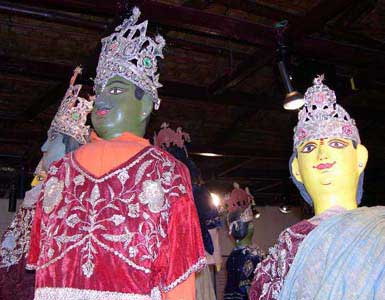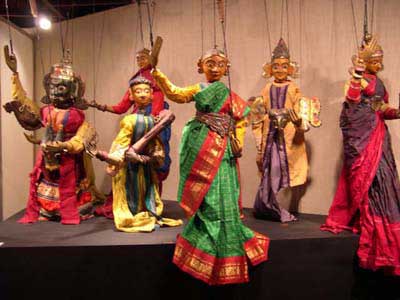PUPPET FESTIVAL IN NEW DELHI, 2003
by Elisabeth den Otter
In March 2003 the Sangeet Natak Akademi in New Delhi organized a large puppet festival, together with the India International Centre and the Indian Council for Cultural Relations. The festival was held in honour of the 50th birthday of the Akademi, and in memory of the late Kamladevi Chattopadhyay. 35 Groups performed, of which 18 traditional groups from different states: Karnataka (4), West Bengal (3), Andra Pradesh / Kerala / Orissa / Tamil Nadu (2 each), and Rajasthan / Maharashtra / Assam (1 each). For twelve nights different groups performed, ususally accompanied by live music.
At the occasion of the festival an exhibition was organized, showing around 200 puppets from the collection of the Sangeet Natak Akademi. A lovely sight! (Photo's of a number of these puppets can be seen in the article below.)
There was also a two-day symposium with the title 'Puppetry: East-West, West-East', in association with the Union Internationale de la Marionnette (UNIMA). My contribution consisted of a lecture about the exhibition 'Distant Friends of Jan Klaassen', shown in the Tropenmuseum in 1996. The organization was excellent and being there was a fantastic experience!From March 17-28 a large number of puppet groups performed, traditional as well as contemporary. The majority of the puppets were stringpuppets (sometimes combined with rods) and shadowpuppets; there were only a few groups with glovepuppets. The stories are mostly based on the Ramayana, but also on the Mahabharata and folk stories. Music is an important part of puppetry; the melody is played on a harmonium or a shawm, and the percussion is played on a variety of drums, cymbals and other instruments. Puppetry often is part of a temple festival, and lasts a number of evenings; often the performance is preceded by a ritual.
- glove puppets, Kerala
- glove puppets, West Bengal
- shadow figures, Kerala
- rod & string puppets, Karnataka
- rod & string puppets, Tamil Nadu
- rod puppets, Orissa
- shadow figures, Orissa
- shadow figures, Tamil Nadu
- string puppets, Andra Pradesh
Kerala
Glovepuppetry is called pavakathakali in Kerala. The puppeteers have adapted the dance stories of kathakali. The puppets are between thirty and sixty centimeters high. The head and arms are carved out of wood; the head is manipulated by the index finger and the arms are moved by the thumb and the middle finger. The conventions of kathakali character types in respect to costumes, headgear, make-up and color are followed in pavakathakali. A green face indicates a god, king or hero, whereas a red face indicates a villain. The musical instruments consist of drums, cymbals and a conch shell. The play Dakshayagam is from the Mahabharata: Daksha, the stepfather of Sati (wife of the god Shiva), insults Shiva by not inviting him for an important ceremony. Sati goes, in order to try and reconcile her stepfather and her husband, but is received with anger by her stepfather who insults her husband. Sati immolates herself. In great fury, Shiva comes to the ceremony transformed into the demon Virabhadra. He cuts off Daksha's head and throws it into the sacrificial fire, but revives him and fixes a goat's head on his body. Daksha begs Shivas pardon. The lively and colorful performance was much appreciated.
The puppets seen in the following video are manipulated by the group Natanakairali, which was established in 1981 to revive the art of traditional Kerala puppetry.
Shadowpuppetry is called tolpavakuthu in Kerala. The leather puppets are traditionally performed by the Vellala Chetty, the Nair and Ganaka communities. The performers are known as Pulavars, the scholars or poets. The theme, the story of Rama from his birth to his coronation, is performed from seven to twenty-one nights. The performance is a part of temple festivities and is conducted with a series of rituals. At least five artists are required to manipulate the puppets to cover the twelve meters long screen. The puppets made of deer skin are opaque and small, about fortyeight to eighty centimeters high. Almost 130 puppets are needed for the telling of the entire story. The recitation of verse and prose is in a specific style; the musical accompaniment is provided by drums and cymbals. It is very exciting to watch the performance from behind the scene: the puppeteers that have to manipulate the right puppets at the right moment, the interaction that goes on, the intense singing, the percussive music ...
The puppets seen in the following video are manipulated by the group Krishnan Kutty Pulavar Memorial Tholpava Koothu & Puppet Centre.
Puppetry in Kerala has been revived thanks to Natanakairali, a center for research and performance of traditional arts: puppetry (glove- and shadow-), kutiyattam (an old form of Sanskrit theater), and mohiniyattam (a classical female dance form). This center was founded in 1975 by Gopal Venu, together with his wife Nirmala Paniker; their daughter Kapila is a kudiyattam actress and mohiniyattam dancer. Thanks to this center a number of theatrical traditions from Kerala have been saved from extinction; they are kept alive through performances and publications.
Rajasthan
Stringpuppetry is called kathputli in Rajasthan. The heads of the puppets are carved from mango wood, their large stylized eyes are painted white or yellow. They are up to sixty centimeters tall, costumed in the Rajasthani style, with bodies made of cloth and stuffed rags. They are manipulated with only one string, one end of which is attached to the puppet's head and the other to its back. The string is looped around the puppeteer's finger and all movements are generated by a series of jerks on either end. The puppeteer 'speaks' for the characters in a squeaky voice with a swizzle; the women sing and play the drum. The puppeteers are 'bhats', a wandering community; they believe in a divine origin of their art, claiming to be the chief performers during the reign of the legendary king Vikramaditya, whose life and achievements they extolled. The stories mostly revolve around the exploits of local heroes. Amar Singh Rathore, the ruler in the seventeenth century, was a great patron whose heroic deeds and death are sung and enacted. He appears at the court of emperor Akbar, along with other Hindu 'rajas'. Tricks and turns are performed for their royal amusement by a magician, an acrobat, a horse rider, a snakecharmer, etc.
Karnataka
Karnataka is rich in puppetry. Stringpuppetry is called yakshagana gombeyata and resembles the Yakshagana theater performances, especially in regard to the themes, the structure of performance, music, costumes and make-up. Here also, an episode of the Ramayana is the theme. The puppet is manipulated with six strings, two each attached to the ears, knee joints and hands. These pairs are tied to three small wooden sticks, held in the hands of the manipulator who also sings for the character he manipulates. Musical accompaniment consists of drums, cymbals and a shawm.
String&rodpuppetry is called salaki gombeyatta. Both strings and rods are used for manipulation. In addition to the strings, the puppets have an iron stick extending from each hand to form a rod, with the other end fixed in a wooden handle. The strings at one end are tied to the ears and the centre of the head of the puppet, and at the other end to a cloth-covered iron ring placed on the head of the manipulator. This technique enables the puppets to perform special actions or effects, such as lighting a lamp or garlanding another character. The puppeteer can also push the heavy puppets with his knees to create more movement. They perform scenes from the Ramayana.
The puppets seen in the following video are manipulated by the group Sri Bhavaneshwari Sutrada Gombe Mela.
Shadowpuppetry is called togalu gombeyata. The performance opens with an invocation to Ganesh, followed by an episode from the Ramayana.
Andra Pradesh
Shadowpuppetry is called tolubommalata in Andra Pradesh. The leather puppets are large and brightly colored. The puppeteers speak, sing and dance for the characters they manipulate standing up. They are accompanied by a harmonium, drum and cymbals. Their ankle-belled feet stamp on two wooden planks, one on top of the other, to keep rhythm or for sound effects. The men and women in the group sing and speak for respective male and female characters. The stage is made with transparent cloth tied to poles on three sides. The story is from the Ramayana, and comic relief with local gossip and caustic comments on the contemporary situation is provided by clownesque characters. The combination of color, sound and movement is magic ...
Stringpuppetry is called koyya bommalata, literally: 'wooden doll' . It is a very old tradition. Thirty to one hundred puppets are required for a performance based on the theme of the play. An episode from the Ramayana is performed. The musical instruments are a harmonium, a drum and cymbals.
The puppets seen in the following video are manipulated by a group led by Mr Mote Uppalaiah.
Orissa
Orissa is a state rich in puppetry. Shadowpuppetry is called ravanachhaya, literally: 'the shadow of Ravana'. The performers are from the 'bhat' community, whose ancestors were musicians and officers in the local royal courts. The shadows are created by simple opaque leather puppets. Deer skin is used for divine beings, while the skin of mountain goats and sheep is used for all the other figures. The leather is not scraped fully and the puppets are not painted; the dark silhouette, delicately outlined, is defined by very few incisions for clothing and jewellery. They are small, with no joints. The manipulation is simple, with up and down and sideways swinging movements. Illusion of size is achieved by the distance of the puppet from the screen. Musical accompaniment is provided by a drum, wooden clappers and cymbals. The play is from the Ramayana.
The puppets seen in the following video are manipulated by the group Ravan Chhaya Natya Sansad.
Stringpuppetry is called sakhinata. The small puppets have three strings which are attached to a small wooden rod: one for the head and two for the hands. Puppetry is a speciality of the Kela; this ethnic group is also known for its diviners, snake charmers and magicians. The play is based on the epic 'Mathura-Mangal', in which the young Krishna is the main character: the tricks he plays as a child, his flute playing and flirting with the milkmaids and Radha as a young man, and his batlles with the demons his mean uncle sent to him.
Rodpuppetry is called kandhei nach. The puppets measure up to sixty centimeters and are jointed at the shoulders. The wooden rod holds up the head, which is carved in wood and painted. The shoulder joints are connected with strings from inside the torso of the puppet to two rings which are pulled for arm movements. The play, an episode from the Ramayana, is preceded by an invocation.
The puppets seen in the following video are manipulated by the group Utkal Vishwakarma Kalakunja Kandhei Nacha.
West Bengal
Glovepuppetry is called benir putul. The two male and female characters, with terracotta faces and wooden hands, are constantly sparring with each other. The puppets keep the rhythm with bells or cymbals tied to their wrists. The repertoire is from the epics, with some modern, topical touches added to keep pace with the times, be it an anti-smoking message or a projection of new roles for women.
The puppets seen in the following video are manipulated by the group Bishnu Priya Putul Party.
Rodpuppetry is called danger putul. The play is based on the Ramayana. The puppets are accompanied by a harmonium, a shawm, drums, and cymbals. There is the operatic singing, broad gestures, the declamatory delivery of dialogue and the ornate costuming.
Tamil Nadu
Shadowpuppetry is called tol bommalatam. Somewhat akin to shadowpuppets from Andra Pradesh and Karnataka, these puppets are smaller in size. The theme is taken from the Ramayana. Musical accompaniment is with a harmonium, a drum and cymbals.
The puppets seen in the following video are manipulated by the group Selvaraja Shadow Puppet Group.
String&rodpuppetry is called bommalatam and closely resembles the string&rodpuppetry of Karnataka. Both strings and rods are used for manipulation. In addition to the strings, the puppets have an iron stick extending from each hand to form a rod, with the other end fixed in a wooden handle. The strings at one end are tied to the ears and the centre of the head of the puppet, and at the other end to a cloth-covered iron ring placed on the head of the manipulator. The play is based on the Ramayana. As in the traditional theater forms of the region, the play begins with an invocation to Ganesh, and includes the clowning of the jester. Two singers, one male and one female, along with a flute, drum and cymbals, accompany the performance.
The puppets seen in the following video are manipulated by the group Sri Murugan Sangeetha Bommalatta Sabha.
This festival was an excellent occasion to see fascinating performances, to attend interesting lectures, and to talk about puppetry with old and new friends.
Literature
S.A.Krishnaiah: 'Karnataka Puppetry'
Udupi: Regional Resources Centre for Folk Performing Arts, 1988M.Nagabhushana Sarma: 'Tolu Bommalata. The Shadow Puppet Theatre of Andra Pradesh'
New Delhi: Sangeet Natak Akademi, 1985E.den Otter: 'Verre Vrienden van Jan Klaassen. Poppenspel in Afrika en Azië'
Amsterdam: KIT/Tropenmuseum, 1995J.Pani: 'Living dolls. Story of Indian puppets'
New Delhi: Ministry of Information and Broadcasting, 1986F.M.Seltmann: various books and articles, mainly about shadowpuppets
G.Venu: 'Puppetry and lesser known dance traditions of Kerala'
Irinjalakuda: Natana Kairali, 1990G.Venu: 'Tolpava Koothu. Shadow puppets of Kerala'
New Delhi: Sangeet Natak Akademi, 1990
More about puppetry

